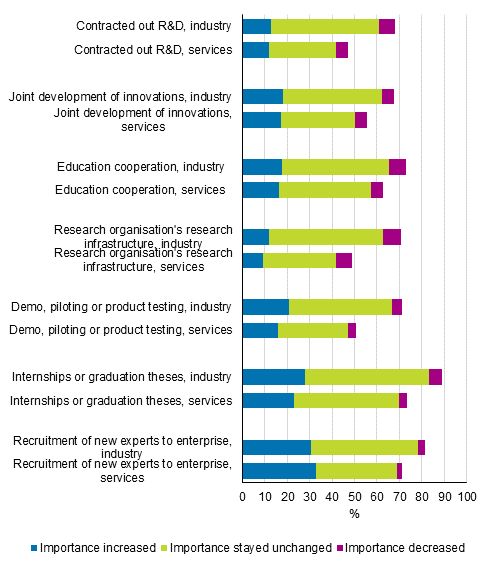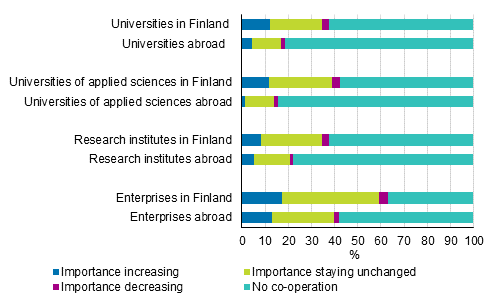16. Cooperation between enterprises and research organisations
In this survey, cooperation between enterprises and research organisations refers to organised, active cooperation, as well as other transfer of know-how, collaboration and goal-oriented interaction or communication. Research organisations refer to both domestic and foreign universities, universities of applied sciences and research institutes.
In all, 23 per cent of enterprises reported cooperation with research organisations in 2016 to 2018. Fifteen per cent of enterprises had had innovation cooperation with research organisations and 17 per cent other cooperation.
Cooperation with universities was reported by 16 per cent of enterprises. Fifteen per cent had had cooperation with universities of applied sciences. Eleven per cent of all enterprises had been cooperating with research institutes.
Table 2. Cooperation with research organisations in 2016 to 2018, share of enterprises, %
| All NACE, total | Universities | Universities of applied sciences | Research institutes | Co-operation by type |
| Innovation co-operation | 11.0 | 6.8 | 7.9 | 14.6 |
| Other co-operation | 10.1 | 11.5 | 6.6 | 16.8 |
| Co-operation by organisation | 15.7 | 14.5 | 11.3 | 22.8 |
| Industry | Universities | Universities of applied sciences | Research institutes | Co-operation by type |
| Innovation co-operation | 15.2 | 10.5 | 11.7 | 19.9 |
| Other co-operation | 13.3 | 15.7 | 9.5 | 22.0 |
| Co-operation by organisation | 21.2 | 20.5 | 16.4 | 29.7 |
| Services | Universities | Universities of applied sciences | Research institutes | Co-operation by type |
| Innovation co-operation | 7.9 | 3.9 | 4.9 | 10.6 |
| Other co-operation | 7.6 | 8.3 | 4.4 | 12.9 |
| Co-operation by organisation | 11.6 | 10.0 | 7.5 | 17.5 |
The most commonly mentioned results of cooperation were an overview of future trends and markets, introduction of a new technology, method or device and new or improved products. In manufacturing the most often mentioned result was the introduction of a technology and in service industries, the overview of future trends and markets.
The least often mentioned results of research organisation cooperation were access to, or progress on, international markets and participation in international research and innovation programmes.
Results of the university cooperation were most commonly felt to be strengthening the knowledge base and competence including patents and other intellectual property rights and overview of future trends and markets. Views concerning the future were assessed in service industries considerably more commonly than in manufacturing. After them, introduction of a new technology and product development were cited most often.
Those having cooperated with universities of applied sciences also selected most generally as the results of cooperation introduction of a new technology especially in manufacturing, an overview of future particularly in service industries and new and improved products in both manufacturing and service industries.
Cooperation with research institutes produced in manufacturing most generally new or improved products, further widened cooperation, strengthened the knowledge base and competence, also in the form of patents and other intellectual property rights, and offered an overview of future trends and markets, which was also seen most often in service industries as a result of cooperation with research institutes.
Table 3. Results of cooperation with research organisations in 2016 to 2018 or expectations concerning results by the end of 2020, shares of those having cooperated with different research organisations
| Enterprises with co-operation with universities | Enterprises with co-operation with universities of applied sciences | Enterprises with co-operation with research institutes | |
| % | % | % | |
| Strengthening the knowledge base and competence including patents and other IPR | 47.5 | 25.6 | 39.8 |
| An overview of future trends and markets | 45.1 | 28.0 | 43.5 |
| Introduction of a new technology, method or device | 41.8 | 33.4 | 35.9 |
| New or improved products (goods or services) | 42.0 | 31.9 | 40.6 |
| Access to, or progress on, international markets | 15.0 | 6.8 | 26.6 |
| Widening of cooperation with research organisation | 36.4 | 17.3 | 38.9 |
| Participation in international research and innovation programmes | 22.3 | 7.4 | 29.9 |
| Other results | 2.8 | 4.9 | 0.8 |
Nearly 60 per cent of those having cooperated had contracted out R&D and good 60 per cent had joint development of co-creation and use of research organisation’s research infrastructure and services. Demos, piloting or product testing were also cooperated on by good 60 per cent of those having cooperated. Forms of cooperation were reported more generally in manufacturing enterprises than in service industries.
Cooperation with research organisations concerned most commonly education and students in 2016 to 2018. Over 80 per cent of those having cooperated – in manufacturing 89 per cent and in services 74 per cent of enterprises having cooperated – had collaborated with students in the form of internships or graduation theses. In all, 77 per cent of those having cooperated had recruited new experts to the enterprise, and 68 per cent had had education cooperation.
The majority of those with various types of cooperation with research institutes assessed the forms of cooperation had stayed unchanged in 2016 to 2018, but recruitment of new experts was quite generally regarded as having grown in importance from before. Internships and graduation theses were also seen as having grown in significance considerably, especially in manufacturing. Next most commonly growth was assessed as having taken place in joint development of co-creation and education cooperation and in piloting and product testing in manufacturing.
Figure 27. Forms, prelevance and development of importance of cooperation made with research organisations in 2016 to 2018 compared to before in total industry and services, share of enterprises having cooperated with research organisations

Enterprises in manufacturing reported slightly more often than service industries about their cooperation plans in the near future related to innovation activity. Most commonly cooperation was planned with Finnish enterprises, 72 per cent of manufacturing enterprises and 56 per cent of service enterprises. Next most generally cooperation was assessed to be made with Finnish universities of applied sciences, in manufacturing 53 per cent and in services 35 per cent.
Plans to cooperate with foreign enterprises were slightly more common, 47 per cent of manufacturing enterprises and 38 per cent of service enterprises than with Finnish universities, 44 and 32 per cent, respectively, or with Finnish research institutes, 49 and 29 per cent, respectively.
In relative terms, the importance of cooperation was estimated to grow with Finnish universities and foreign enterprises, but almost equally much was expected of collaboration with domestic enterprises and universities of applied sciences.
Figure 28. Estimate of the importance of cooperation partners for R&D and other innovation activity to the end of 2020, share of all enterprises

Further information about cooperation between enterprises and research institutes by industry and size category
Cooperation between enterprises and research institutes by industry group and enterprise size categoryCooperation between enterprises and research institutes by industry
Source: Innovation 2018, Statistics Finland
Inquiries: Mervi Niemi 029 551 3263, Heidi Pirkola 029 551 3246, tiede.teknologia@stat.fi
Director in charge: Mari Yl�-Jarkko
Updated 23.4.2020
Official Statistics of Finland (OSF):
Innovation [e-publication].
ISSN=1797-4399. 2018,
16. Cooperation between enterprises and research organisations
. Helsinki: Statistics Finland [referred: 19.4.2024].
Access method: http://www.stat.fi/til/inn/2018/inn_2018_2020-04-23_kat_018_en.html

